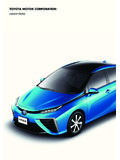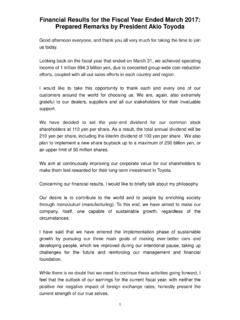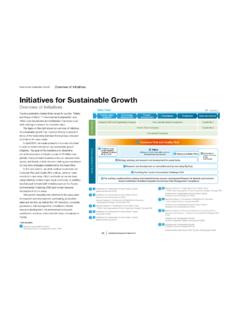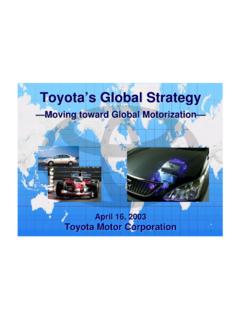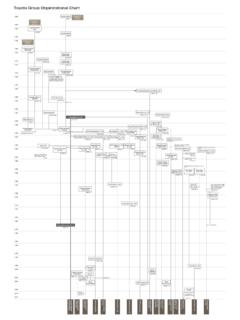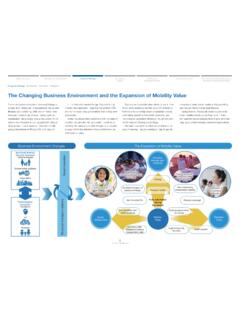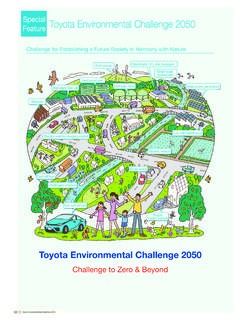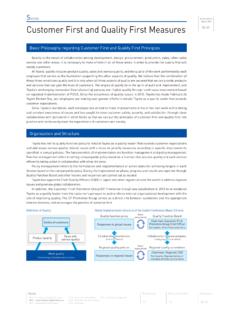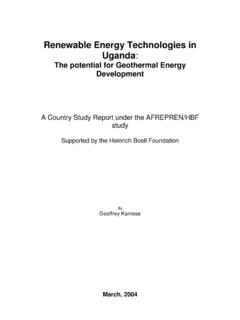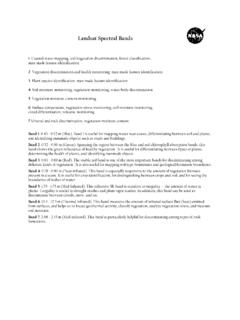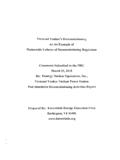Transcription of Toyota Environmental Challenge 2050
1 Toyota s Environmental Initiatives 2015 03 SpecialFeatureChallenge for Establishing a Future Society in Harmony with NatureToyota Environmental Challenge 2050 Challenge to Zero & BeyondSolar power generationSolar power generationSolar power generationSolar power generationSolar power generationSolar power generationGeothermal heatGeothermal heatGeothermal heatGeothermal heatGeothermal heatGeothermal heatPlug-in hybrid vehiclehybrid vehiclehybrid vehiclehybrid vehiclePlug-in hybrid vehicleFuel cell vehicleFuel cell vehicleFuel cell vehicleFuel cell vehicleFuel cell vehicleFuel cell vehicleWind powerWind powerSmall-scale hydropowerSmall-scale hydropowerBiomassBiomassBiomassBiomassBi omassElectric vehicle charging stationElectric vehicle charging stationElectric vehicle charging stationElectric vehicle charging stationElectric vehicle charging stationElectric vehicle charging stationElectric vehicle charging stationElectric vehicle charging stationElectric vehicle charging stationElectric vehicle charging stationElectric vehicle charging stationElectric vehicle charging stationElectric vehicle charging stationFuel cell busFuel cell busFuel cell busElectrolytic CO2-free hydrogenHydrogen tankHydrogen tankHydrogen tankHydrogen tankHydrogen tankHydrogen tankHybrid vehicleHybrid vehicleHybrid vehicleHybrid vehicleHybrid vehicleHybrid vehicleHybrid vehicleHybrid vehicleElectric vehicleElectric vehicleElectric vehicleElectric vehicleElectric vehicleElectric vehicleElectric vehicleFuel cell forklift truckFuel cell forklift truckFuel cell forklift truckFuel cell forklift truckFuel cell forklift truckFuel cell forklift truckFuel cell forklift truckFuel cell forklift truckFuel cell forklift truckFuel cell forklift truckFuel cell forklift truckFuel cell forklift
2 TruckFuel cell forklift truckFuel cell forklift truckStationary fuel cellStationary fuel cellStationary fuel cellStationary fuel cellStationary fuel cellStationary fuel cellStationary fuel cellStationary fuel cellStationary fuel cellStationary fuel cellHydrogen stationHydrogen stationHydrogen stationHydrogen stationHydrogen stationHydrogen stationHydrogen stationHydrogen stationHydrogen stationHydrogen stationHydrogen stationHydrogen stationHydrogen stationHydrogen stationHydrogen stationHydrogen stationHydrogen stationHydrogen stationHydrogen stationHydrogen stationToyota Environmental Challenge 2050 Toyota s Environmental Initiatives 201504To move toward a net positive impact rather than just trying to reduce negative factors to zero, Toyota has set itself six challenges. All these challenges, whether in climate change or resource and water recycling, are beset with difficulties, however we are committed to continuing toward the year 2050 with steady initiatives in order to realize sustainable development together with society.
3 Aiming to Establish a Future Society in Harmony with Nature Six Challenges of ToyotaNew Vehicle Zero CO2 Emissions ChallengeChallenge1 Life Cycle Zero CO2 Emissions ChallengeChallenge2 Plant Zero CO2 Emissions ChallengeChallenge3 Challenge of Establishing a Future Society in Harmony with NatureChallenge6 Challenge of Establishing a Recycling-based Society and SystemsChallenge5 Challenge of Minimizing and Optimizing Water UsageChallenge4 Toyota Environmental Challenge 2050 Zero Environmental Impact ChallengeContributing to a Better Society through Net Positive ImpactChallenge of Achieving ZeroNet Positive Impact ChallengeSince its foundation, in 1937, Toyota has been consistently committed to the idea of contributing to society by manufacturing automobiles, and leading innovation through technology and creativity. This spirit of Challenge that stands up to change has been handed down to us today through the company s DNA.
4 Looking forward too, we would like to continuously contribute to society through our business activities and to carry on being a company that customers choose and that brings a smile to every customer. We have considered the ideal form of a new mobility society and tackled serious Environmental issues head-on, while positioning our contribution to the development of a sustainable society as a key Challenge for management. The development of the world s first mass-produced hybrid vehicle, the Prius, and the fuel cell vehicle MIRAI, reflect this spirit of unprecedented Challenge . We were able to overcome numerous difficulties and launch these cars due to the strong support we have received from many people. Despite these energetic initiatives, the global environment remains in a critical situation. Extreme weather conditions attributed to climatic changes driven by greenhouse gases threaten our livelihood.
5 Meanwhile, the seriousness of Environmental issues is increasing over a wide area, with population growth, accompanied by water shortages and resource depletion, and degradation of biodiversity due to the fragmentation of ecosystems. In response to the situation, we need to take on new challenges that consider the world 20 or 30 years in the future, in order to remain closely aligned with the global environment. This means not merely trying to reduce negative factors associated with automobiles as close to zero as possible, but at the same time, looking beyond zero, challenging ourselves in all- Toyota initiatives toward a net positive impact. It also means a further strengthening of these initiatives in collaboration with all stakeholders who share our aspirations. We will consolidate new ideas, dynamism and technology to tackle together the realization of a truly sustainable society. We have started to take on this new Challenge aimed at a society where people, automobiles and nature coexist in harmony, providing a bright future for our children, with clear skies.
6 Toyota s Environmental Initiatives 201505 Toyota Environmental Challenge 2050 SpecialFeatureNew Vehicle Zero CO2 Emissions ChallengeAs if to demonstrate the fact of global warming, extreme weather patterns worldwide have been provoking successive disasters. If current conditions continue and increased measures are not taken to reduce greenhouse gases, it is estimated that by 2100 the world s average temperature will have risen by C. It is further estimated that, to hold the temperature rise since before the Industrial Revolution to below 2 C, we will not only have to reduce additional CO2 emissions to zero, but will need to achieve an actual positive trend through absorption.* While the world is trying to move toward below 2 C scenario, Toyota has, under the New Vehicle Zero CO2 Challenge , decided to Challenge itself to reduce vehicle CO2 emissions by 90 percent in comparison with 2010 levels, by 2050.
7 To realize this, in addition to mileage improvement of engine-driven vehicles, Toyota will promote the development of next-generation vehicles with low or zero CO2 emissions hybrid, plug-in hybrid, electric, and fuel cell vehicles and further accelerate the spread of these vehicles. When these eco-friendly vehicles come into widespread use, they can start making a contribution to society. Toyota will also cooperate with relevant stakeholders to provide possible support as an automobile manufacturer toward the provision of the infrastructure for widespread adoption of electric and fuel cell Cycle Zero CO2 Emissions ChallengeBy Lifecycle Zero CO2 Emissions Challenge , we mean efforts to reduce to zero not simply the CO2 emissions produced in traveling and manufacturing, but all CO2 emissions including in the processes of materials production, and disposal and recycling of vehicles. For instance, there are some next-generation vehicles that do achieve reduced CO2 emissions when driven, but actually cause increased CO2 emissions at the material and vehicle production stages.
8 Because of this, we will further promote environmentally friendly design such as by choosing appropriate materials. In this way, we are going to pursue Always Better Cars. For example, we will develop and expand the use of materials with lower CO2 emissions during production and will reduce the quantity of materials and number of parts used in a vehicle. We will also adopt more recycling and biological materials for vehicle production and enhance the initiative aimed at easy to dismantle design. Challenge of Establishing a Recycling-based Society and SystemsWith the worldwide increase in population and the pressure for economic growth and convenient lifestyles, the consumption of resources is accelerating. If present trends continue, large-scale exploitation of natural resources will result in depletion, and appropriate disposal will be unable to keep pace with the increasing amounts of waste generated by mass consumption, resulting in Environmental pollution.
9 To improve resource efficiency toward an ideal resource-recycling based society (circular economy), initiatives are needed in four key areas: (1) utilization of eco-friendly materials; (2) making use of parts longer; (3) development of recycling technology; (4) making vehicles from the materials of end-of-life vehicles. These last two apply to the whole of the automotive industry. Toyota has been working for 40 years on the Challenge of resource recycling, leading the world by developing world-first technologies and in terms of scale of operations. Going forward, by rolling out to the world the technology and systems evolved in Japan and developing them into the future, we will continue working on the Challenge of establishing a recycling-based society. Challenge of Establishing a Future Society in Harmony with NatureIf humans and nature are to coexist into the future, we need to conserve forests and other rich natural systems in all regions.
10 However, deforestation is progressing around the world, so that every year, forest equivalent to 14 percent of Japan s land area is lost. To realize our aim of enriching lives of communities in each region, the Toyota group companies have engaged in planting trees at plants, Environmental conservation activities in their surrounding area, and Environmental education. Going forward, the insights gathered so far will be used to promote activity at Group, region, and organization level. Among the variety of activities we are rolling out are the Toyota Green Wave Project, which aims to connect regions with green corridors; the Toyota Today for Tomorrow Project, providing assistance for Environmental activities that connect to the world; and the Toyota ESD Project, contributing to Environmental education that connects to the future. Our aim is to establish a society where humans and nature coexist in harmony.
